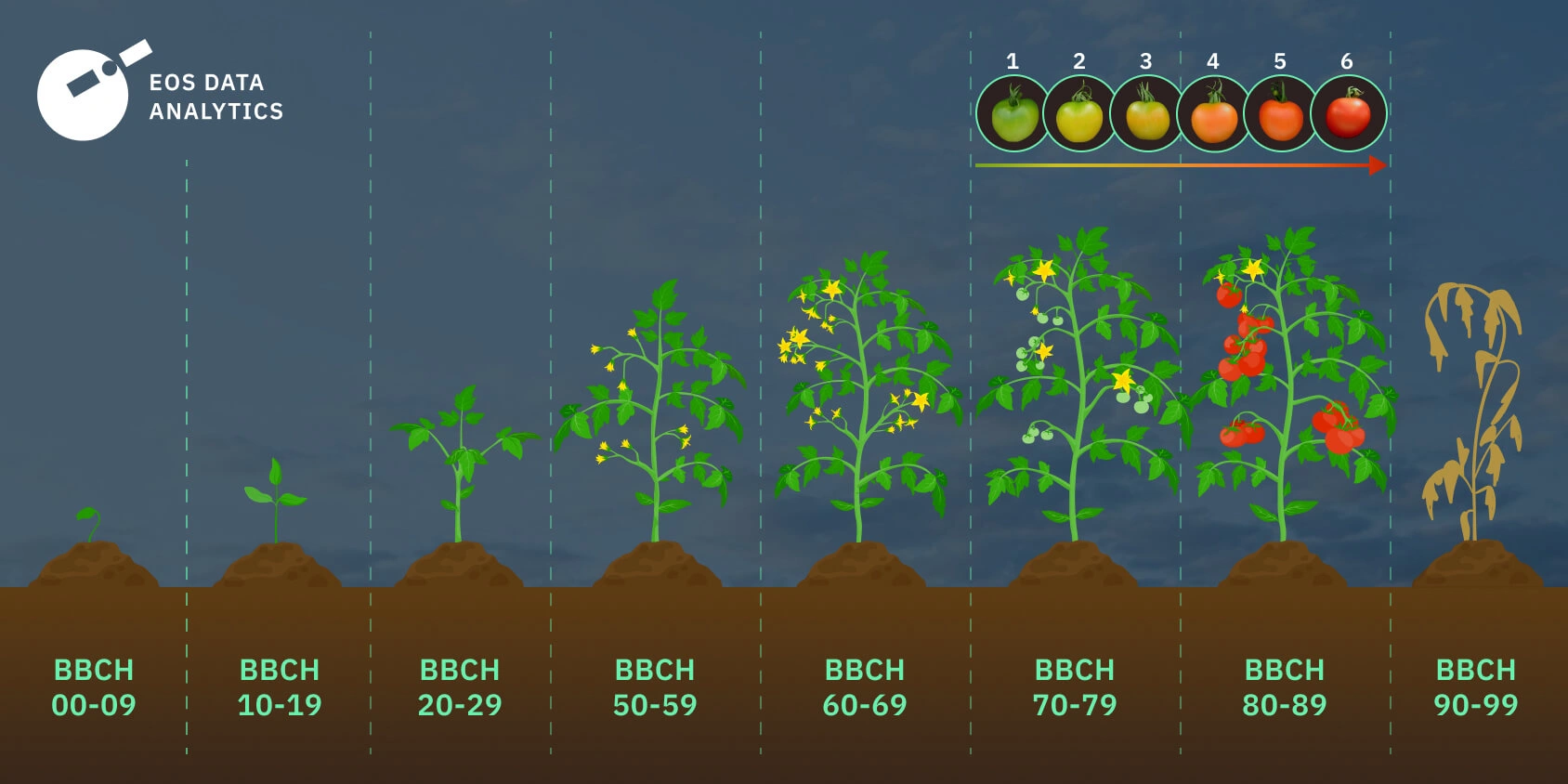
The recommendations provided in this article serve as general guidelines. Particular cultivation requirements may vary based on the unique conditions of each field and the selected hybrids.
Tomato Growth Stages To Ensure High Crop Production
The tomato plant is an in-demand agricultural commodity so cultivating this crop on a large scale can bring financial stability to farmers. To maximize yields, it is important to know tomato growth stages and fully support specific plant needs at each period of its development. The identification of tomato plant stages streamlines crop care, which is easier with remote field monitoring facilities. Regular crop health control at all stages of tomato plant growth promotes well-weighted agricultural decisions that can impact the quality and quantity of yields in a given season, as well as the overall long-term productivity of the field.
BBCH Tomato Growing Stages
The BBCH scale is the most popular classification of plant growth stages that includes ten phases, from seed germination to senescence. Tomato growth stages have certain peculiarities in determinate and indeterminate types. In particular, the apical side shoots in indeterminate cultivars emerge simultaneously with inflorescences (growth stage 5), so growth stage 2 for such plants can be skipped.
Tomato plant growth stages according to BBCH scale
BBCH 00-09: Germination
Germination is the first among the tomato life cycle stages, which is critical for further plant health and growth. Seed germination in tomatoes starts at 68°F to 78°F (20°C to 25.5°C). Apart from suitable weather, it is also essential to provide favorable soil conditions during crop growth, and the stage of tomato seed germination kickstarts the plant development. Tomatoes grow most efficiently in light and nutrient-rich soils.
Tomatoes can be planted either by seeding or transplanting. Tomato is a cold-sensitive crop, so the method preference greatly depends on the climatic peculiarities of each growth region. Seeding is cheaper and more productive since it allows for covering vaster areas in a shorter period. At the same time, to promote tomato germination stages, perform seeding activities when the air and soil temperatures are already warm enough but there is still enough moisture at the planting depth (around 0.4 inches or 1 cm).
Typically, soil moisture is no longer available in the subsurface at shallow depths when it is warm already except in the tropical regions that are simultaneously warm and wet. For this reason, farmers practice transplanting in most areas or use the seeding method with consistent irrigation events. Transplant tomato cultivars are known for higher prices and lower planting productivity but also earlier and potentially richer yields.
To ensure proper crop development and encourage tomato seedling stages, make sure that the growth environments are favorable. However, sowing or transplanting dates may vary for different hybrids and cultivars because they have different disease and heat/cold stress resistance, overall performance and productivity.
In general, this crop can be planted in the open soil 4-6 weeks before final frosts. In the case of indoor sowing, the sprouting begins in 5-10 days after digging the seeds.
Since sowing is one of the most important activities of tomato production, the conditions during the sowing period play an important role. Air and soil temperature, field moisture, and the availability of nutrients are essential factors of growth.
With the EOSDA Crop Monitoring platform you can get reliable AOI-specific meteorological forecasts and soil moisture data. Also analyze historical weather archives to figure out the general trends of warmth and moisture in a particular field, for optimal planning of sowing dates so that tomatoes could have enough warmth and moisture, as well as the need for additional watering at every stage of tomato growth.
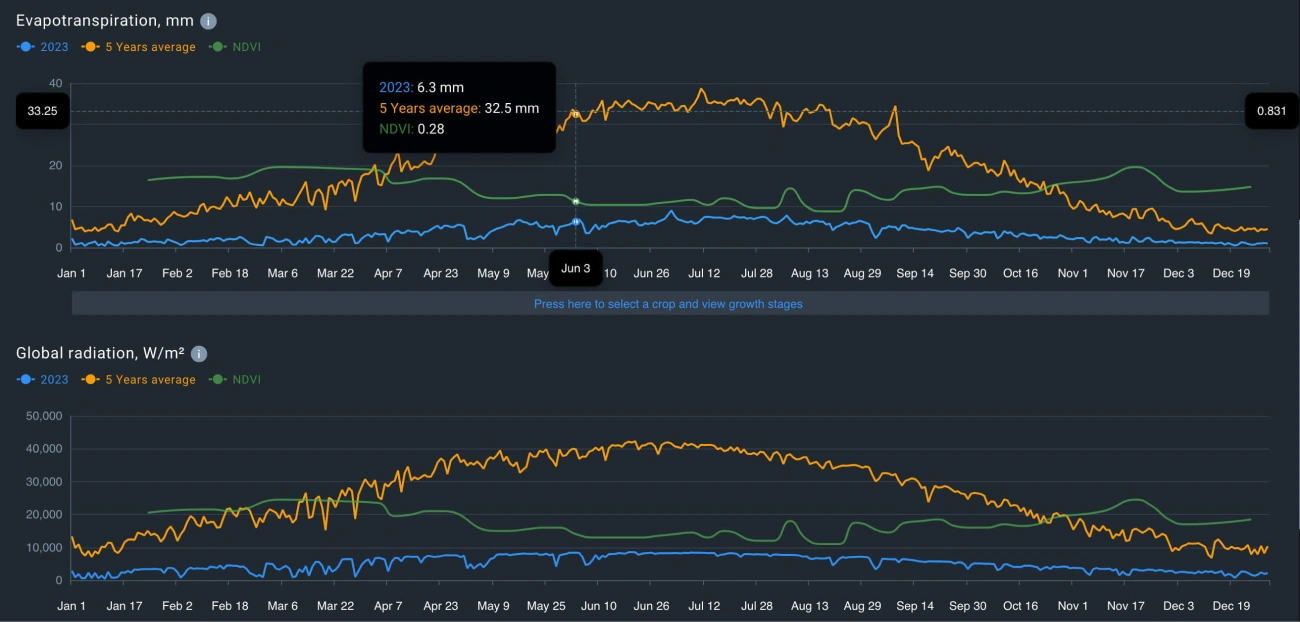
Additionally, VRT maps will help determine the productivity zones of the field for variable rate seeding and pre- and post-emergence (including transplanting) fertilization.
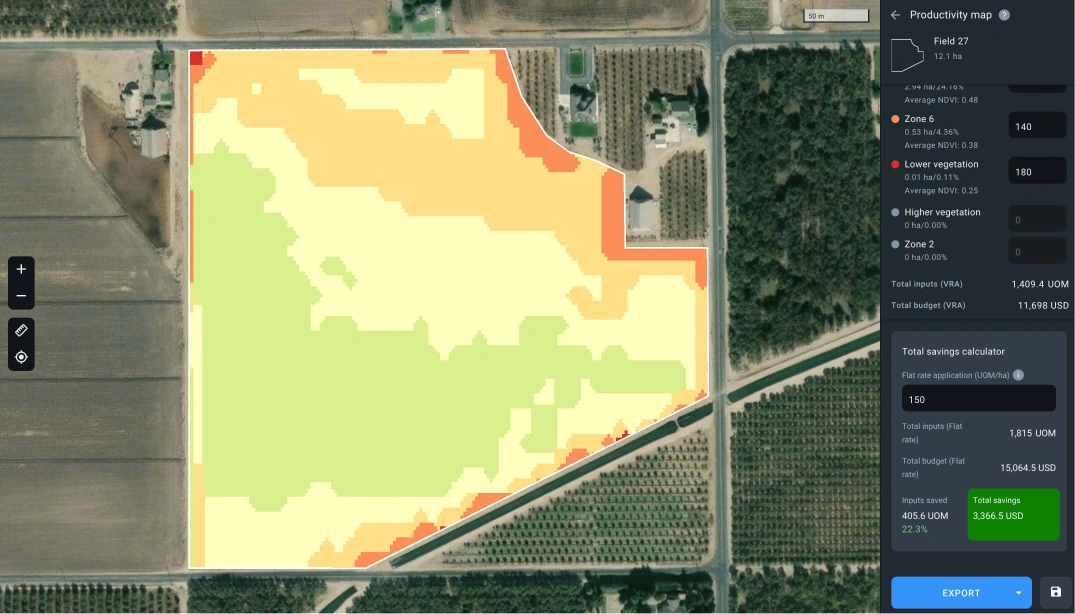
BBCH 10-19: Leaf Development
This stage of tomato plant growth is marked by active cotyledon development, vital for photosynthesis and encouraging foliage, therefore, provide your plants with a sufficient amount of available nutrients, light, and moisture.
At this tomato vegetative stage, much attention should be paid to monitoring and controlling weeds that, among other damage, can also host disease-causing agents like tomato yellow leaf curl virus (TYLCV).
Primarily, it is necessary to focus on preventive measures (pre-planting tillage, mulching, and crop rotation). If these methods fail or cannot be implemented for some reason, mechanical weeding is the way to go, as it is effective and usually practical in tomato production. To eliminate the struggle of the crop for the sun, water, and nutrients with weeds, conduct regular scouting. By combining the MSAVI index with the scouting feature on EOSDA Crop Monitoring, you will conveniently control the field state during all the stages of tomato growth and take action only if the index value increases in certain areas compared to the entire field, which will indicate an abnormal amount of vegetation in the field, quite possibly due to weeds.
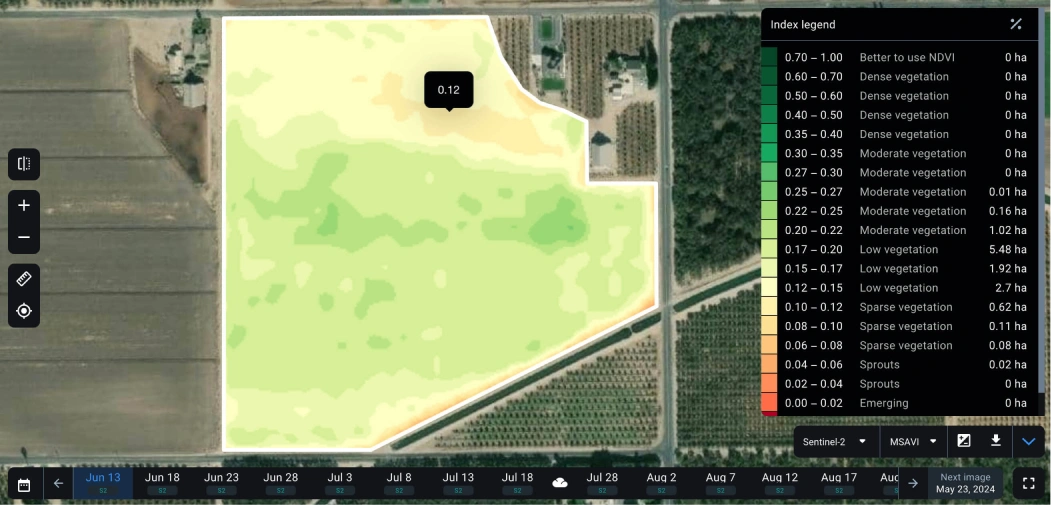
Weeding is not advisable if the plants suffer from bacterial or fungal infections and/or when they are wet, to prevent disease spreading. Integrated tomato production does not allow for chemical weed control, which is harmful to humans and nature.
BBCH 20-29: Formation Of Side Shoots
This tomato growth stage is recognized by active branching. The plant develops in height and width, rapidly gaining leaf and stem mass. Leaf growth stages differ in determinate or indeterminate plants.
Indeterminate cultivars vine and produce fruits all season long. The growth of determinate plants continues until they reach their full height and produce all fruit at once. Determinate plants ripen simultaneously, which makes their harvesting easier at commercial farms. Different ripening time of indeterminate plants provides vegetables throughout the entire growth season.
Active plant growth at this tomato stage requires sufficient fertilizing and continues over 20 to 25 days. The plant’s tap roots penetrate the soil 3 feet (90 cm) deep making it able to carry heavy fruits while the shallow roots are 8-12 inches (20-30.5 cm) deep in the subsoil to transport nutrients.
Plant care at this tomato growth stage includes:
- regular and even irrigation (1-2 inches / 2.5-5 cm weekly);
- 10-10-10 NPK fertilization;
- pruning for air circulation and productivity increase.
Regular field monitoring enables consistent support of crop water needs for successful growth. Tomatoes develop best in evenly watered soils. Waterlogging at this stage of growth induces chlorosis and root rots while droughts will lead to blossom-end rots and poor fruit formation. Both excessive and insufficient moistening may halt plant growth and eventually kill the crops.
BBCH 50-59: Inflorescence Emergence
Inflorescence formation marks the transition from vegetative tomato stages to reproductive ones when the primary shoot meristem turns into an inflorescence that can be either a cyme or raceme. Cymes are determinate and develop into a floral bud, and the next floral meristem emerges on the flank of the previous flower (either on the same or opposing sides of the peduncle – helicoid and scorpioid cymes respectively). Racemes are indeterminate and don’t end with a flower, rather floral meristems form on the flank of the inflorescence meristem .
This tomato growth stage is very important for crop productivity because more inflorescences mean more floral buds and, potentially, more fruits.
BBCH 60-69: Flowering
The tomato plant flowering stage in tomatoes starts when the plants burst into a yellow bloom that terminates into small green fruits after pollination. Abundant flowering is supported with potassium (K) and phosphorus (P), so nitrogen (N) applications should be reduced at this time. Pollination is essential for fruit production and greatly relies on insects and wind. You can also slightly shake self-fertile plants or use brushes to increase pollination.
Weather conditions at the tomato plant flowering stage also have a significant impact on pollination success. For example, at daytime temperatures above 85 °F (29.5°C), pollination fails because pollen becomes sticky. Temperature fluctuations will cause flower loss, as well as night temperature drops below 55 °F (about 13°C).
Determinate varieties turn into bloom at the same time while indeterminate ones produce flowers throughout all periods of growth.
Sadly, the weather is beyond farmers’ control. At this growth stage of tomato, it is also difficult to slow down the inflorescence formation and the flowering process in general. Nonetheless, some farmers cut the first flowers off to prolong the vegetative stage of their plants. Yet, if the high temperatures negatively affected the crop’s growth, and many flowers were simply lost, you still can compensate for the losses with crop insurance. The insurance case can be proved with EOSDA Crop Monitoring. Just set the high and low temperature limits, and the system will send automatic notifications about hot/cold spell periods during the stages of growth. Additionally, the duration of such periods can be tracked on retrospective graphs.

Because tomatoes are very sensitive to droughts during the entire period of growth, moisture deficiency will essentially reduce the crop’s productivity but the beds must not be immersed in water. Regular watering is vital at the tomato growth stages of flowering and fruiting. Irrigation rates depend on the soil and weather conditions. Tomatoes need 0.8 inches (2 cm) of water weekly on cooler days and 2.75 inches (7 cm) of water weekly in hotter and dry periods of growth. Irrigation is important for even maturing and prevention of flowering rots that cause calcium deficiency in fruits. The recommended frequency of irrigation events during this stage of growth is 7-8 days. On hot days, water your plants every 5-6 days .
As tomatoes have a taproot root system, it is best to monitor the root-zone soil moisture at this stage of tomato growth. Tomato roots can reach 24-35 inches (60-90 cm) in depth in search of water and nutrients. Using EOSDA Crop Monitoring and analyzing the field soil moisture data, you can easily plan irrigation activities and maintain favorable moisture conditions and uninterrupted water supply to the plant if natural moisture (rain, groundwater) cannot support the plant growth, which commonly occurs in poor but loose soils.

BBCH 70-79: Development Of Fruit
The fruit development stage in tomatoes continues until the green fruit reaches its final growth size. Pollinated flowers wither and drop revealing small green fruits. It is critical to provide the crop with consistent irrigation to avoid water stress that may result in blossom end rot or fruit cracking. Developing a consistent irrigation plan at different stages of tomato growth, use the above-mentioned EOSDA Crop Monitoring features:
- root zone soil moisture,
- NDMI index map,
- field leaderboard.
The obtained data will enable ongoing control of soil moisture and adjust irrigation and fertilization events to support healthy fruit growth.
Pollinated flowers drop within 24 hours and their stems become green. The stems in unpollinated flowers become yellow. As for the description of this tomato growth stage in days, marble-sized fruits appear within the first weeks and their growth speeds up after 3-5 weeks. Moisture deficiency will reduce fruit formation, so at the tomato fruit development stages support the plants with NPK fertilizers (nitrogen ratio should be low) and water them regularly.
To make sure that your field has enough phosphorus (P), potassium (K), and calcium (Ca) for tomato fruit growth, use the VRA maps in EOSDA Crop Monitoring. Apply potassium (K), phosphorus (P), and calcium (Ca) compounds relying on historical productivity zones to avoid excessive fertilization in growth areas where these substances may have accumulated over the years. For example, calcium deficiency can cause blossom end rot during the tomato flowering stage, while low potassium content in the soil during plant growth can be the reason for dotty or ununiformed ripening,
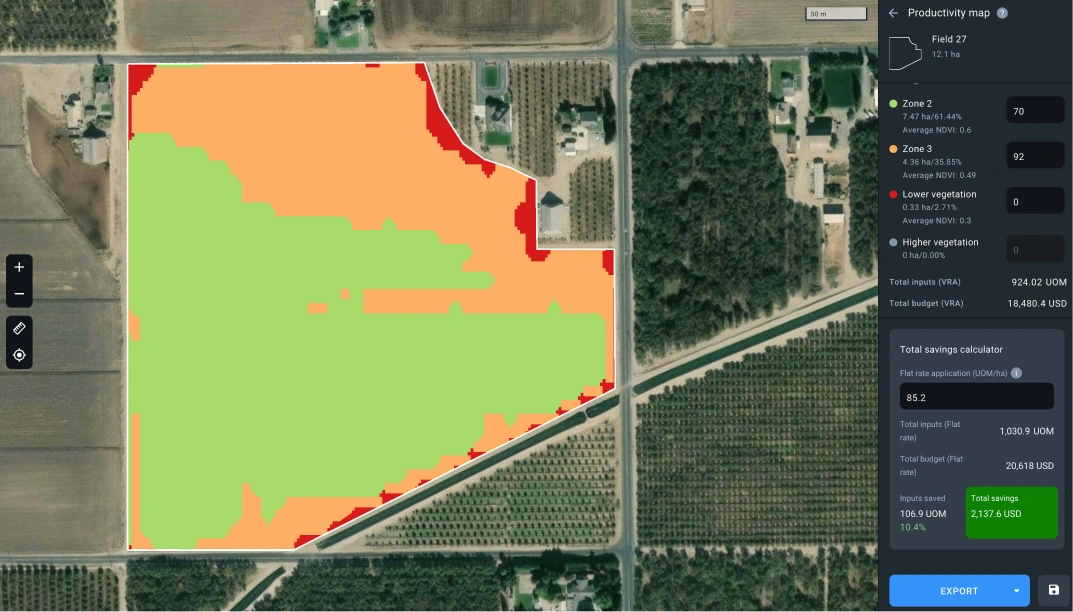
BBCH 80-89: Ripening Of Fruit And Seed
Tomato ripening is accompanied by color changes in tomato fruits that acquire red, pink, yellow, orange, or even black hues typical for numerous hybrids, including marble heirloom varieties. The color change signals the production of specific acids and sugars that build up the tomato fruit flavor. The growth stage of tomato ripening occurs at 68-77°F (20-25°C) and requires successful irrigation and sunlight management.
Irrigation at the tomato ripening stage must be decreased with the first signs of tomato fruit blushing to promote the production of pigments and flavor. While tomatoes require abundant sunlight for ripening, excessive sun will harm the fruits causing sun scalds (white or pale yellow burns), ununiformed ripening (the so-called green shoulders), and poor nutritional and flavoring properties.
To correctly determine harvesting dates, farmers should distinguish between early and mature ripening periods of tomato growth.
Early Ripening
The early tomato ripening growth phase includes the green, breaker, and turning stages. Tomatoes need a favorable growth environment to ripen. Without consistent care, ripening will fail.
At the green stage, the fruits complete their growth and reach their full size, yet they are still hard, green, and have poor taste.
The plants may stop developing at this stage of tomato ripening when they try to survive in unfavorable growth environments, particularly saving moisture and nutrients under heat stress, excessive watering, or in compacted soils. Tomatoes can’t produce carotene and lycopene which provide them with their final color.
Green shoulders also appear after drought periods or under heat stress. Planting heat-resistant hybrids and consistent irrigation may be a solution to potential risks of tomato yield losses.
The tomato breaker stage is identified by the first blush, or initial signs of coloration (about 10%) that start from the inside.
The turning growth stage shows up to 30% of color and determines the earliest possible harvesting time when tomatoes have a chance to ripen off the plant.
Mature Ripening
The final tomato life cycle stage is mature ripening that consists of pink, light red, and red phases. Most cultivars gain their intensive color in 20 to 30 days after their green fruits become full-sized. Tomato fruits gain their color thanks to ethylene – a phytohormone that accelerates pigmentation.
Pink stage fruits reveal 30-60% of their final color which intensifies during the next one or two weeks.
Light red stage tomatoes are nearly ripened and can be harvested.
Red stage fruits have a deep color and taste and should not be left on the plant to prevent cracking and destruction by insects and birds. The storage life of such fruits is short.
Harvesting
The harvesting of tomatoes must not start earlier than their growth is marked by the mature-green stage. This plant growth stage can be identified by the fruit’s innards so it is necessary to cut it to see if you can already harvest them or not. Mature-green tomatoes are jelly-like in their locules, with completely developed seeds.
Some farmers start picking up their tomatoes at the mature green growth stage with subsequent ripening acceleration with ethylene gas but it is more common to harvest the fields at the tomato breaker stage. Quality tomatoes should be waxy and free of any mechanical or growth imperfections like sun scalds, cracks, bruising, or damage from insects, hail, and other factors. The fruit must have a minimal acceptable size, yet quite many producers expect to get larger fruits .
Tomato harvesting management and monitoring is easier with custom solutions by EOSDA. In particular, we offer the following:
- regular yield estimations;
- harvested index (status) of a field on a particular date;
- harvesting dates for each field;
- number of harvested fields on a particular date.
All this information helps to keep tabs on the harvesting operations by comparing the data submitted by farmers with the data from satellite images provided by EOSDA.
If tomatoes are harvested manually in the open field, they are good enough to be sold as vegetables. However, it is much more cost-effective to use manual harvesting in greenhouses. If the harvesting process is mechanized, the tomato yield is typically used for further processing.
BBCH 90-99: Senescence
At this tomato growth stage, the field is harvested and only the plant residue remains. Post-harvesting management of tomato plant residue implies its composting reduces agricultural wastes and helps improve soil fertility by enriching beneficial microbes’ diversity and promoting a healthy rhizosphere .
The growth stages of tomato hybrids may differ, but our research and development team can provide this data upon request. The only thing our scientists need is the information from the customer on the grown hybrids.
About the author:
Vasyl Cherlinka is a Doctor of Biosciences specializing in pedology (soil science), with 30 years of experience in the field. He attended the engineering college in Ukraine and received his degree in agrochemistry, agronomy and soil science in the Chernivtsi National University. Since 2018, Dr. Cherlinka has been advising EOSDA on problems in soil science, agronomy, and agrochemistry.